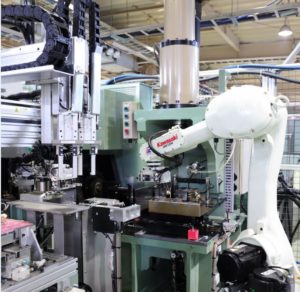Designing a production system to manufacture a product is a complex and challenging task. Process engineers and company management must decide on the labor, equipment, and methods they will use to produce a quality product in the desired output volumes. Cost and lead time of custom equipment, production rate, process risk, product lifecycle, flexibility, safety, available floor space and hourly rates of operators all factor into the matrix they use to decide on a solution. The skill set and ability of plant support personnel to maintain and troubleshoot complex robotic systems and automation equipment, in case of breakdown, also needs to be factored into the equation.
What Is a Lean Work Cell?
For those unfamiliar with the term, Lean Work Cells and Lean techniques, also known as the Toyota Production System, have been utilized by manufacturing companies for over 50 years. The definition of lean in the purist form is “the endless pursuit towards the elimination of waste.” When engineers utilize Lean principles to design a production line, the result is a highly flexible, lower cost work cell utilizing very manual processes. Minimal automation and material handling equipment is specified. However, the increased labor content of a lean cell can drive the operating costs over time to a much higher level than that of a fully automated hard tooled system or hybrid semi-automatic systems. What should you do?
Consider a “Lean Cell” or Flexible Robotic Solution When…
- The product design itself dictates manual assembly, therefore automation equipment is expensive and very high risk.
- There are low and/or unstable volumes forecasted.
- The product lifespan is short or unknown.
- The equipment needs to be flexible, easily modified and run multiple product families.
- The product design is projected to change in the near future.
- The cost of labor is low and plentiful.
Consider Hard Tooled Automation When…
- There is a stable product design that is not likely to change.
- There are very few or no unknown process variables.
- A high volume, short cycle time, is required.
- A long product life span is projected.
- Labor costs are high, and the supply is limited.
- Ergonomics makes the work dangerous for operators.
- The parts have been designed for automatic processes; therefore, automation equipment is relatively easy and inexpensive.
Consider a Hybrid System When…
- A solution utilizing a combination of manual, flexible and hard tooled automatic assembly makes sense.
- The product design can easily be broken into stable sub-assemblies.
- Parts and/or subassembly buffers, between operations, could be beneficial due to process instability.
- There are some unknown process variables, so a modular and flexible approach lowers risk.
The Best Solution
The best solution depends on your particular set of circumstances and the company’s goals. Therefore, ask questions, consider all the variables and solicit the opinions of your co-workers and manufacturing experts.
It may also be beneficial to engage the help of an equipment builder with a long history of success and expertise in your particular industry. They will work with you to develop the “best value” solution for your unique situation. Contact Keller Technology to learn more about possible solutions to your most challenging manufacturing problems. Our goal is to be your long-term supplier of custom, integrated automation and process equipment.

